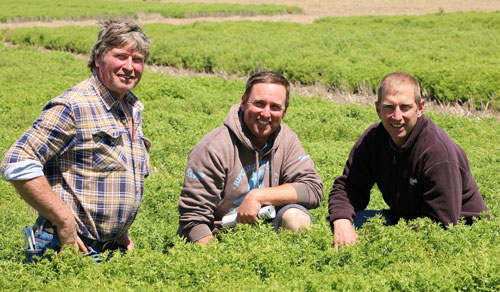Southern Australia
November 16, 2016
Pulse crops continue to add value to farming enterprises across the southern cropping region, as a result of favorable commodity prices and advances in research and development that have underpinned the expansion in area.
The Grains Research and Development Corporation-funded Southern Pulse Agronomy program has made a significant contribution to the rise in pulse production across the south through improvements in crop agronomy and development of management practices that aim to ensure the long-term profitability of pulses for the region’s growers.
Also funded by Agriculture Victoria and the South Australian Research and Development Institute (SARDI*), Southern Pulse Agronomy is integrated with Pulse Breeding Australia (PBA), assisting with germplasm enhancement programs for the delivery of new varieties that are well suited to growers’ evolving farming systems.
Agriculture Victoria pulse agronomist Dr Jason Brand, who heads up the Southern Pulse Agronomy program, says pulses are offering growers multiple agronomic and economic benefits and their worth is being realised by more and more growers, especially in non-primary areas of production.

John Arnold, Scott Arnold, Jason Brand
“For example, the Wimmera has been the primary area of production of lentils in Victoria, but in the last 10 years we have seen expansion into the lower rainfall southern Mallee,” Dr Brand said.
“And more interest in pulses is being generated out of the central and northern Mallee of Victoria and over the river into southern New South Wales – areas of production in that region could jump quickly in the next few years.”
Improved genetics, increased adaptability to soil types and modern management of pulse crops have also resulted in faba bean production expanding into high rainfall zones, with this year’s bean crop expected to be the largest ever in Victoria.
In addition to financial reward, Dr Brand says pulses are offering growers “another important tool in the toolbox”, driving increased sustainability within their farming systems and overall businesses.
The growing importance of pulses in southern farming systems was evident at the recent Southern Pulse Agronomy Wimmera Pulse Field Day in Rupanyup.
Held in conjunction with PBA and supported by the GRDC, Seednet, PBSeeds, Agriculture Victoria, AGTFoods and Tylers Rural, the field day was attended by more than 170 people, including growers, agronomists, plant pathologists, researchers and grain market analysts.
The field day showcased the latest lentil, chickpea, field pea and faba bean varieties and the agronomic packages for these, and provided an update on research into herbicide tolerance in lentils and faba beans, pulse disease management and commentary from grain marketers.
New varieties addressing agronomic constraints are being taken up rapidly by growers. This is especially the case with lentils: “Most of the lentil varieties currently being grown have been released in the last five years,” Dr Brand says.
“The recently-released herbicide-tolerant variety PBA HurricaneXT already makes up 40 to 50 percent of overall production in southern Australia, and on Yorke Peninsula in SA alone that figure is about 70 pc of production.”
already makes up 40 to 50 percent of overall production in southern Australia, and on Yorke Peninsula in SA alone that figure is about 70 pc of production.”
Dr Brand expects the high-yielding, large red lentil PBA Jumbo2 to be the next dominant variety, given its excellent disease resistance: “I wouldn’t be surprised if a lot of growers switch to PBA Jumbo2
to be the next dominant variety, given its excellent disease resistance: “I wouldn’t be surprised if a lot of growers switch to PBA Jumbo2 next year – if seed is available we could see it making up 30 pc or more of next year’s overall lentil production in Victoria.”
next year – if seed is available we could see it making up 30 pc or more of next year’s overall lentil production in Victoria.”
Rupanyup grower Scott Arnold, whose family farm has hosted this year’s Southern Pulse Agronomy trials and the associated field day, is an early-adopter of new varieties, including PBA Jumbo2 . “PBA Jumbo2
. “PBA Jumbo2 has been standing up really well this year – it’s shown great resistance to botrytis grey mould and ascochyta,” says Mr Arnold.
has been standing up really well this year – it’s shown great resistance to botrytis grey mould and ascochyta,” says Mr Arnold.
The Arnolds these days sow half of their cropping area to pulses and one-third to lentils alone, and despite the disease pressure brought on by a wet growing season, their legumes “are out of the box” this year.
Mr Arnold says advances in pulse varieties, agronomy and farming practices have steered the family’s farming enterprise in a positive direction, with lentils offering an important ryegrass management tool. He is looking forward to enhancing his weed control efforts when breeding programs deliver new lines of beans with herbicide tolerance traits.
Herbicide tolerance and weed ecology, particularly in terms of agronomic management, are among the areas of focus for the ongoing Southern Pulse Agronomy program which, over the next three years at least, will also continue to work on disease management traits.
“We will be looking at traits for management of blackspot in field peas, ascochyta blight in lentils and chickpeas, as well as botrytis diseases in faba beans and lentils,” Dr Brand says.
“Other areas of focus include canopy management through early sowing, seeding rates (to ensure growers are maintaining yields in dry years), and plant growth regulators to manage excessive growth in beans.
“Another key component of the program will be contributing to the variety-specific management packages being produced by the breeding programs, and we also have the flexibility to adapt the program to areas of need, such as harvest quality if the season is conducive to such.
“All the work being undertaken and everything we deliver through the program will by very much closely linked to modern farming systems.”
More information about the Southern Pulse Agronomy program and pulses in general can be found on the GRDC website at https://grdc.com.au